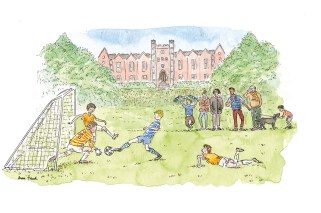It is cold, but not in a cheery, robin-redbreast kind of way. The sky is slate blue; the sun, a red ball, is slipping below the horizon, figures carrying heavy burdens trudge across the frozen water. Yet this far- from-festive painting, ‘The Census at Bethlehem’ by Pieter Bruegel the Elder, is one of the earliest — perhaps the very first — to set the Christmas story in a northern winter landscape.
There is no attempt to pretend that this is the Holy Land. The setting is a village in the southern Netherlands. The houses are brick-built, one with a northern European crow-stepped gable. In the foreground, a pig is being slaughtered, an improbable sight in Palestine.
In his poem ‘Musée des Beaux Arts’ W.H. Auden famously wrote: ‘About suffering they were never wrong,/ The Old Masters’. The gravest events, he went on, occur ‘while someone else is eating or opening a window or just walking dully along’. Actually, it was not the Old Masters in general but Bruegel in particular who depicted momentous dramas in this way, taking place in a sea of unconcerned humanity. Auden’s thoughts were prompted by ‘Landscape with the Fall of Icarus’, in which a ploughman is placidly at work in the foreground, while the mythical youth falls to his death in the sea in the distance behind. In the same gallery of the Musée des Beaux Arts, Brussels, hangs ‘The Census at Bethlehem’.
In this picture, too, most of the figures are oblivious to the ostensible subject. Mary and Joseph are far from prominent; indeed it might take a moment or two to find them. She rides on a donkey, about to slip between two wagons laden with barrels presumably in the direction of the stable (there being no room at the inn on the left). Naturally enough, nobody seems aware they are participants in an event that, in the eyes of Christians, is about to change the world.
A few of the villagers are having fun, mainly the younger element. There is a snowball fight in the middle-distance; to the lower right some hardy souls are skating. But most of the locals are clustered around a table outside the dilapidated tavern on the left. This is the Biblical census, but counting the population was rare in Flanders or anywhere else in 16th-century Europe.
Bruegel has depicted the story as it was told in the Gospel of Luke: ‘And it came to pass in those days, that there went out a decree from Caesar Augustus that all the world should be taxed.’ These people have gathered to hand over money to the government, another reason for the dark mood of the picture.
We know next to nothing about Pieter Bruegel the Elder, the man, including when he was born. But it seems he was 44 at most when he died in 1569. He is hard to pin down: even his name appears in variant spellings (when he was registered in the Antwerp artists’ guild in 1551, it was as ‘Peeter Brueghels’).
In this picture, however, the artist has left a small clue to show what was going on — and perhaps how he felt about it. Hanging on the wall behind the tax-collector’s table is a little notice bearing the double-headed eagle of the Habsburgs. Clearly, the ruler Bruegel has in mind is not Caesar, but Philip II of Spain.
The painting is dated 1566, a significant date in the place in which it was painted. This was the year that public patience snapped in the Low Countries, and one reason why it broke was the burden of taxation. A few decades before, as a result of a complicated series of deaths, battles and marriage alliances, this part of the world — one of the most mercantile and prosperous in Europe — had become part of the empire of Charles V.
Of all his territories — which comprised a good deal of the area contained in the modern EU — Charles identified the Netherlands as the cash cow. The Venetian ambassador calculated that this area paid four times as much tax as the Spanish, and half the revenue of the Habsburg Empire. Charles’s son Philip II continued the policy.
By 1566 there were stirrings of revolt, turning on two issues: a demand for more political autonomy and outrage at religious persecution (the Inquisition was clamping down). On 5 April, 200 nobles — dubbed ‘the Beggars’ — rode through Brussels to present a petition of demands to Philip’s Regent, Margaret of Parma. Bruegel, who was living in Brussels at the time, probably saw them riding past.
Four months later, in August, Calvinist mobs destroyed religious paintings and sculptures in churches, monasteries and convents. This was the Beeldenstorm or iconoclastic fury. The next year, the Duke of Alva arrived with an army and began a brutal crackdown on non-Catholics. There followed 80 years of war, and the division between the north — now the Netherlands — and the south, modern Belgium.
It was also getting colder. The year 1550 is generally reckoned to be the beginning of the ‘little Ice Age’: a chilly period of more than two centuries much argued over by the warring camps of the climate-change debate. There is no question, however, that the winter of 1564–5 was savage. At Antwerp the river Scheldt froze; not far away at Delfshaven an iceberg appeared on the coast.
In the following few years, Bruegel painted several winter landscapes crammed with fresh observation, for example, of how snow rests on a log or a barrel, the way it is churned to dirty slush by many feet or the matt surface of a frozen pond. Among these are three that set the Christmas narrative in a wintery Flemish village: ‘The Census at Bethlehem’, an ‘Adoration of the Kings’ taking in blizzard conditions, and the ‘Massacre of the Innocents’ being carried out, apparently, by Spanish troops.
What Bruegel thought about the political and religious strife around him is documented only by his pictures. An early biographer, Karel van Mander, presented him as an exponent of rollicking visual humour. That is true of some works, but in others there is an undertone of horror at the cruelty he saw around him. It is a fair guess that Bruegel agreed with his friend, the great map-maker Abraham Ortelius, who even-handedly blamed the disasters of the age on ‘Catholic evil’, Protestant ‘dysentery’ and the political ‘fever’ of the Beggars.
Thus Bruegel’s ‘Census at Bethlehem’ was painted in a place that was in the process of breaking up into warring fragments, divided by bitter disputes about who ruled which bit of territory, complicated by an increasingly murderous conflict between groups divided by fine points of theology. At Christmas 2014, it is a state of affairs that seems grimly familiar.






Comments